The Xiaomi 11T & 11T Pro Review: Two Chips, With a Battery Focus
by Andrei Frumusanu on September 15, 2021 9:00 AM EST- Posted in
- Mobile
- Smartphones
- Xiaomi
- Xiaomi 11T
- Xiaomi 11T Pro
System Performance
The comparison of the Snapdragon 888 to the Dimensity 1200 is interesting as we don’t tend to get to compare MediaTek devices very often. In theory, the Snapdragon has much more oompf to it given its higher performance X1 core, but things also depend on software.


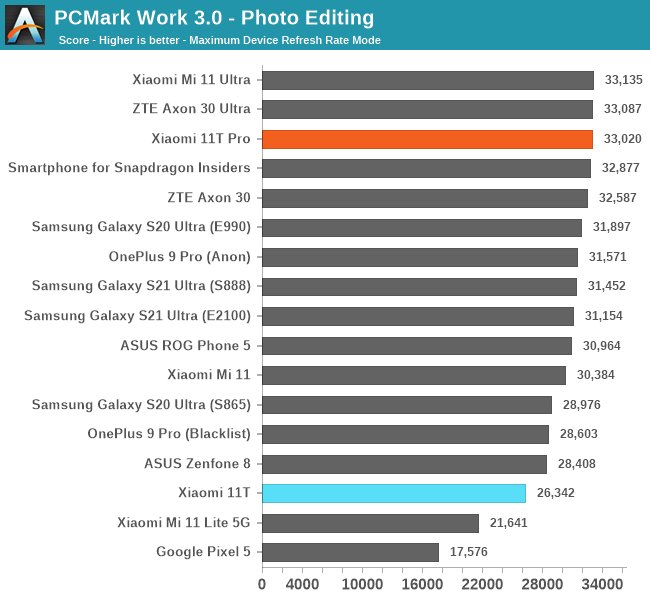
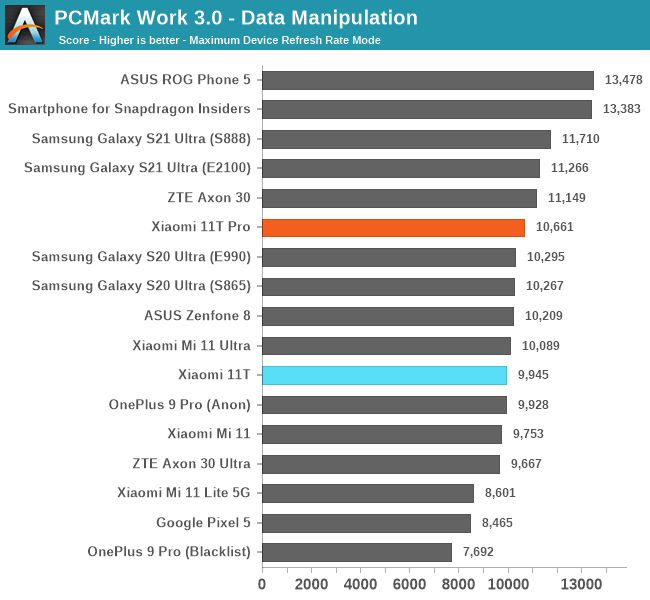
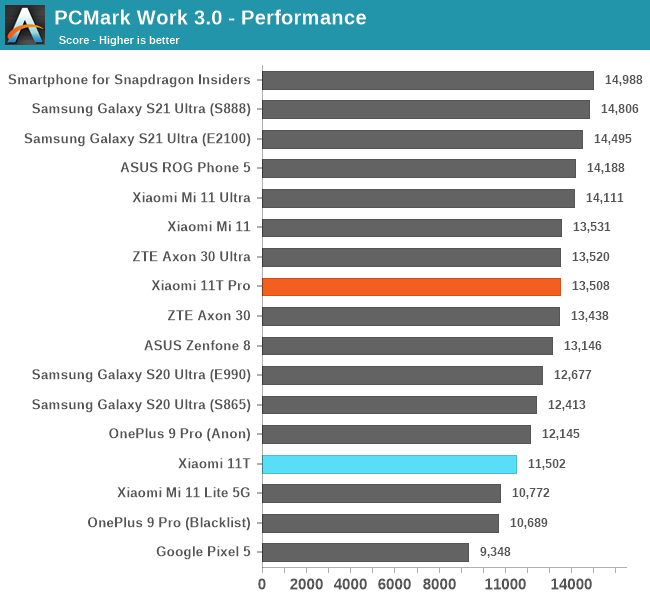
In PCMark, as expected, the Qualcomm powered 11T Pro has no issues in performing quite ahead of the MediaTek powered 11T. It seems that the SoC as well as software stack allows for more aggressive responsiveness on the larger SoC – which is to be expected.
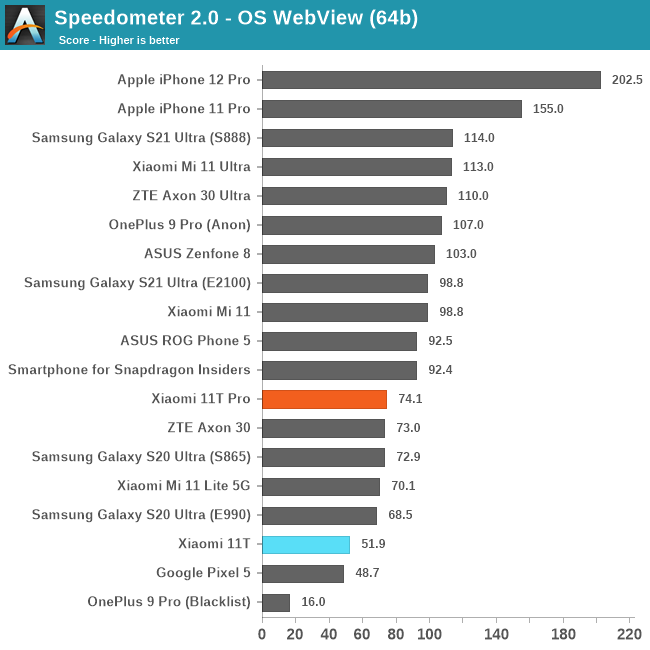
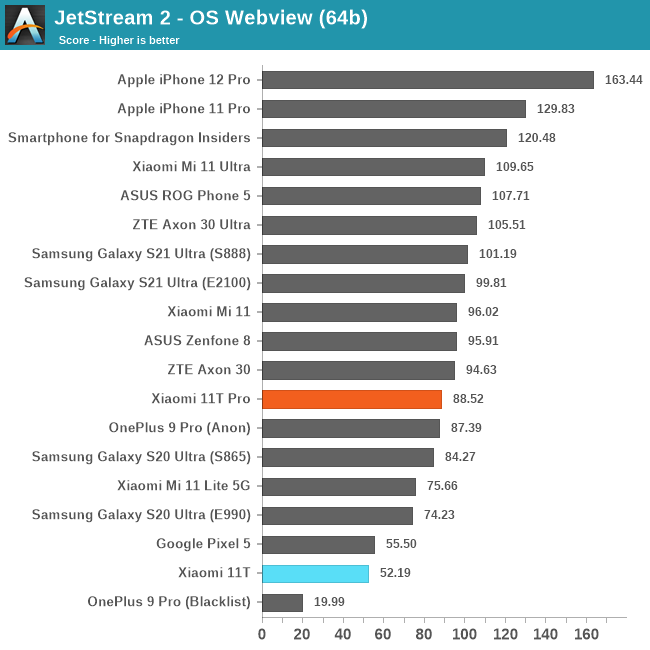
When it comes to the web tests, we also see the 11T Pro easily outperform the 11T, by quite some significant margins even.
What’s a bit weird here is that both devices are actually performing below expectations, and here is where things get very shady:
The Snapdragon 888 in the 11T Pro in these benchmarks is never using the Cortex-X1 cores of the SoC. Instead, pretty much the totality of the tests is being performed on the 2.41GHz A78 cores. If this sounds familiar to you, it’s because we saw some kind of similar behaviour on the OnePlus 9 Pro.
What’s happening on the 11T Pro is that indeed it seems any anonymous workload on the phone is mostly unable to be scheduled on the X1 cores, unless there’s multiple threads which causes spill-over. Without CPU affinity in my SPEC harness, the load gets also scheduled on the A78 cores. If I limit it to just the X1 core, it only goes up to 2.15GHz. In GeekBench, the ST workloads do go up to 2.84GHz even in an anonymised variant of the test, however in the MT load the X1 cores again are limited to 2.15GHz. The X1 cores are still being used here and there in scenarios such as opening apps, but otherwise rarely so.
I can’t really tell if it’s extreme battery optimisation or not, but it’s quite aggressive and the Snapdragon 888 here is definitely handicapped in terms of behaviour.
On the MediaTek Dimensity 1200, the chip fares normally in steady state workloads, however in more interactive workloads such as the above web tests, the DVFS and scheduling behaviour is all over the place with the chip not consistently having the workload on the performance core. I’m also seeing bursts of the other cores needlessly going up in frequency. In general, we don’t have too much experience with MediaTek’s latest software stack, so this would require a bit more investigation, but generally, the phone doesn’t perform quite as well as the raw CPU performance would indicate.
Both phones are fluid at 120Hz, and the 11T Pro is still very responsive, however the 11T doesn’t feel quite as fast.










41 Comments
View All Comments
arayoflight - Wednesday, September 15, 2021 - link
The battery life test of D1200 phone is rather surprising. The OnePlus Nord 2 which uses the same chipset does pretty well in GSMArena's battery test: https://fdn.gsmarena.com/imgroot/reviews/21/oneplu...yeeeeman - Wednesday, September 15, 2021 - link
Yep, I suspect this is a xiaomi thing, not something really bad with the soc, as I would expect mediatek engineer to be able to test power consumption of their soc before releasing it to the market.flipp0 - Thursday, September 16, 2021 - link
Yes, I had the Nord 2 and battery life was great. I think it is likley that anandtech got a faulty 11T unit or that 11T has some kind of software bug draining the battery. I am suprised that Andrei does not mention this a possible explanation for the results reported in this review.Spunjji - Monday, September 20, 2021 - link
Crappy software. Glad to see they fixed it, but that was pretty poor to be releasing a review unit in such a bad state.eastcoast_pete - Wednesday, September 15, 2021 - link
Thanks for the test, especially taking a close look at power management of the SoCs! I guess the overheating issue with the 888 indicates both the appetite of the X1 for power, and the need for good thermal design when used in a close, confined space like a Smartphone. Almost looks as if Xiaomi assumed that designs for older, lower powered SoCs would work just fine with the 888, and was in for a nasty surprise when it didn't.It's too bad that Xiaomi seems to then insist on "improving" these phones with their idea of enhancement by software, which clearly doesn't work. Those results for the Dimensity are also surprising, and not in a good way.
The temperatures measured remind me of an old phone with the SD 808 many years ago; probably the worst SoC QC I ever had the displeasure of owning.
shabby - Wednesday, September 15, 2021 - link
Interesting to see the price difference when the only difference is the soc, Qualcomm sure charges a premium.shabby - Wednesday, September 15, 2021 - link
But ouch that battery life, shirley some software updates might fix this?Spunjji - Monday, September 20, 2021 - link
And they did!PEJUman - Wednesday, September 15, 2021 - link
Curious if Xiaomi is using 'power' cells instead of 'energy' cells on their phones. Or if they are simply pushing energy cells with obscene C rates (at 4V * 4Ah, that's a mere 16 Wh of energy capacity), charging this at 100+ Watts to full is basically 6+ C charging rates.Either they have great battery tech, not sure who is their supplier for these... or the customer will just have to contend with rapid aging of their battery as they fast charge it everyday.
DanNeely - Wednesday, September 15, 2021 - link
Killing batteries early goes right with making battery replacement difficult as a means to drive more sales of new phones.